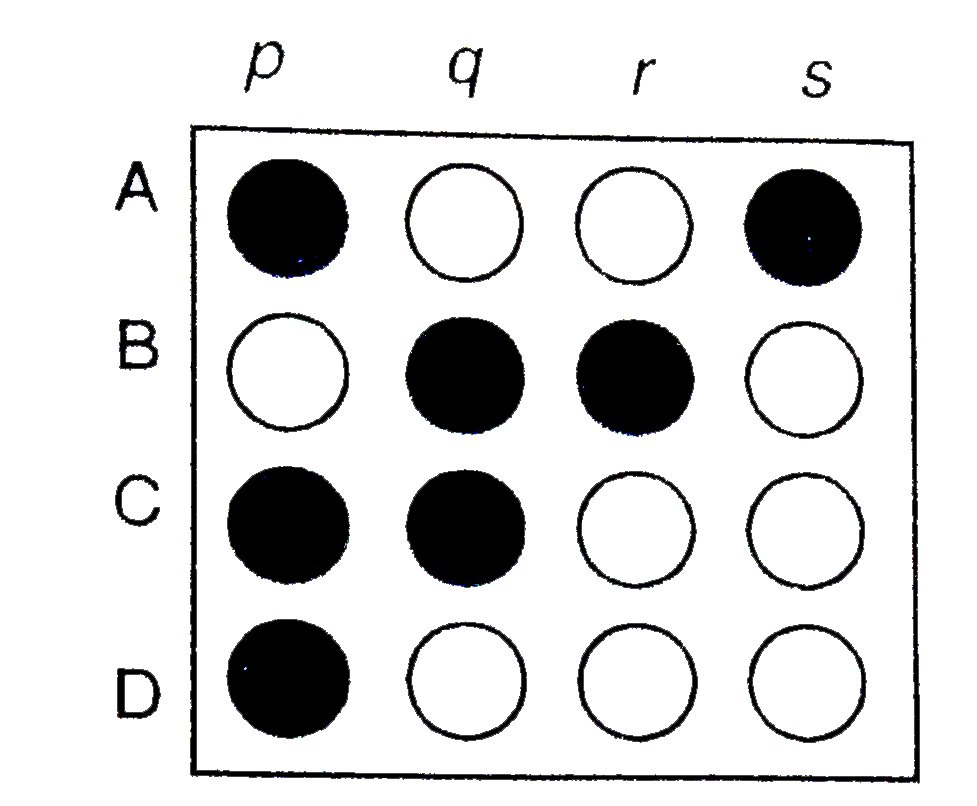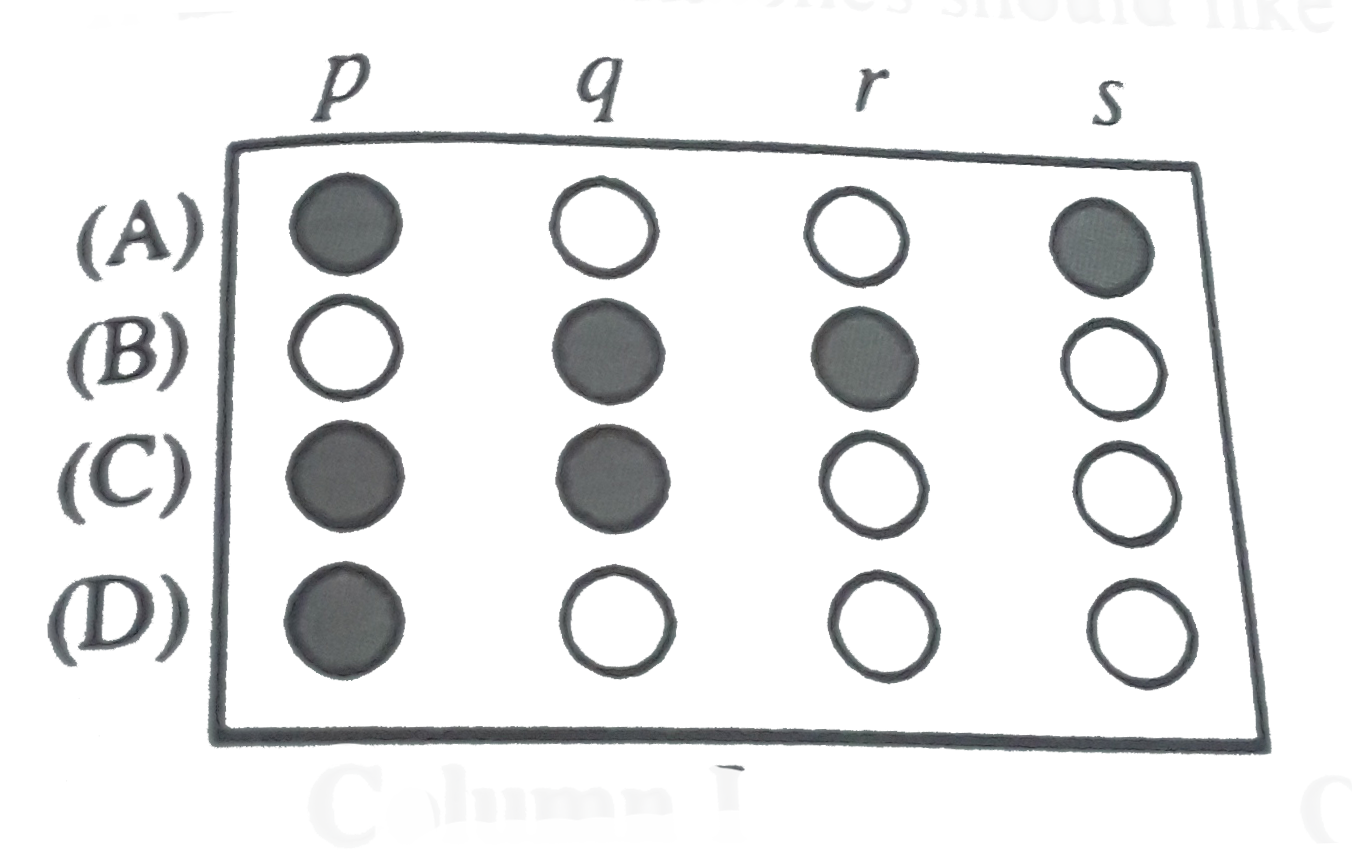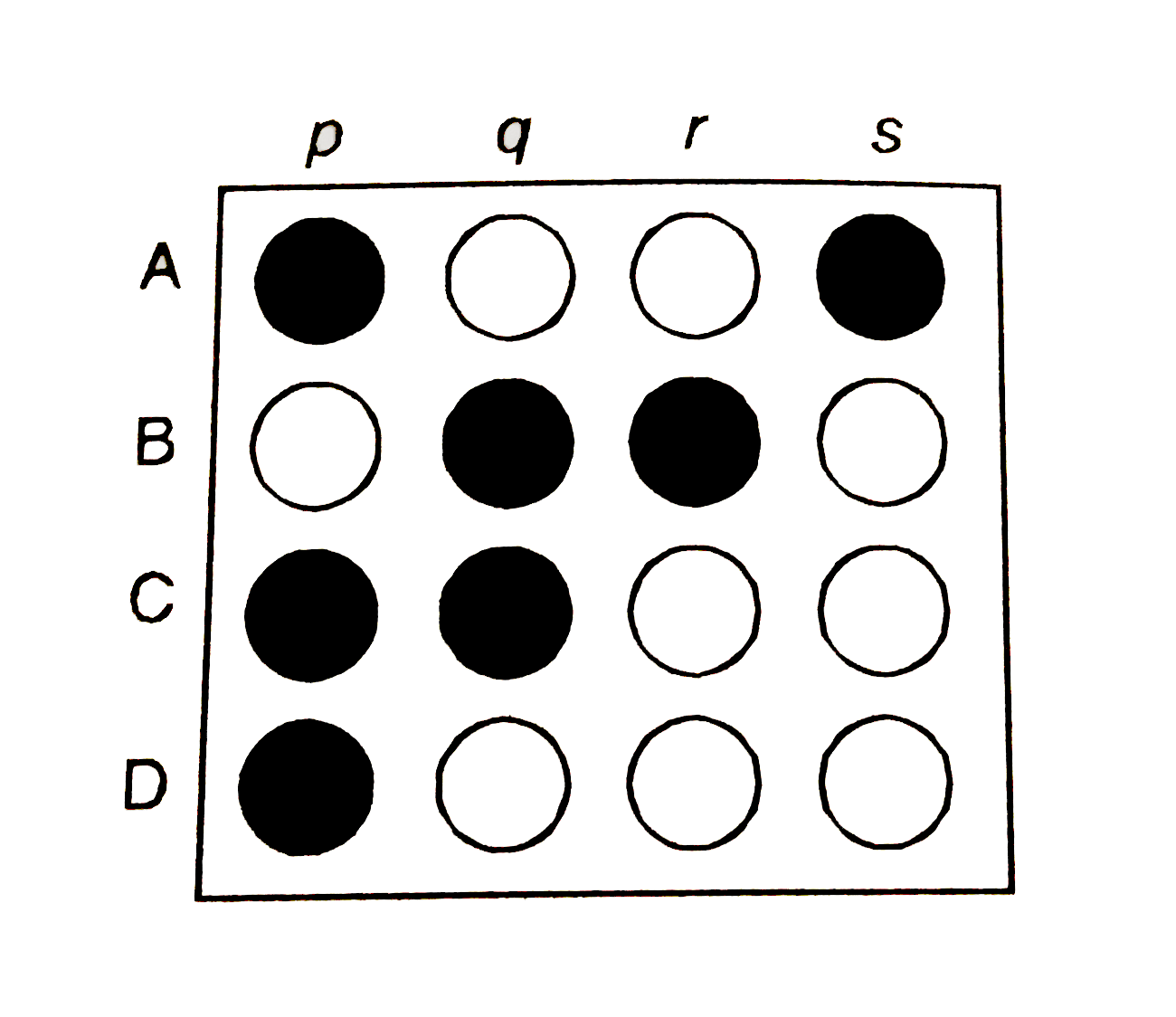A-p, B-q, C-s, D-r
A-r, B-q, C-s, D-p
A-r, B-s, C-q, D-p
A-q, B-r, C-s, D-p
The correct Answer is:B
To solve the problem, we need to match the substances in Column I with their corresponding pH values in Column II. Here's a step-by-step breakdown of the solution:
Step 1: Identify the pH of Milk
- The pH of milk typically ranges from 6.7 to 6.9.
- Therefore, the closest value in Column II is 6.8.
Conclusion for A (Milk):
- A corresponds to (r) 6.8.
Step 2: Identify the pH of Human Saliva
- The pH of human saliva ranges from 6.2 to 7.6.
- The closest value in Column II is 6.4.
Conclusion for B (Human Saliva):
- B corresponds to (q) 6.4.
Step 3: Identify the pH of Human Blood
- The normal pH of human blood is approximately 7.4.
Conclusion for C (Human Blood):
- C corresponds to (s) 7.4.
Step 4: Identify the pH of Lemon Juice
- Lemon juice is known to be acidic, with a pH around 2.2.
Conclusion for D (Lemon Juice):
- D corresponds to (p) 2.2.
Final Matching:
- A (Milk) → (r) 6.8
- B (Human Saliva) → (q) 6.4
- C (Human Blood) → (s) 7.4
- D (Lemon Juice) → (p) 2.2
Answer:
The final matching is:
- A → r
- B → q
- C → s
- D → p
- The pH of milk typically ranges from 6.7 to 6.9.
- Therefore, the closest value in Column II is 6.8.
- A corresponds to (r) 6.8.
- The pH of human saliva ranges from 6.2 to 7.6.
- The closest value in Column II is 6.4.
- B corresponds to (q) 6.4.
- The normal pH of human blood is approximately 7.4.
- C corresponds to (s) 7.4.
- Lemon juice is known to be acidic, with a pH around 2.2.
- D corresponds to (p) 2.2.
- A (Milk) → (r) 6.8
- B (Human Saliva) → (q) 6.4
- C (Human Blood) → (s) 7.4
- D (Lemon Juice) → (p) 2.2
The final matching is:
- A → r
- B → q
- C → s
- D → p
Topper's Solved these Questions
- BOOK - PRADEEPCHAPTER - EQUILIBRIUMEXERCISE - Competition Focus (V. Matrix-Match Type Questions)2videos
EQUILIBRIUM
- BOOK - PRADEEPCHAPTER - EQUILIBRIUMEXERCISE - Competition Focus (VI. Integer Type Questions)12videos
EQUILIBRIUM
- BOOK - PRADEEPCHAPTER - EQUILIBRIUMEXERCISE - Competition Focus (III. Multiple Choice Questions( Based on the given Passage/Comprehension))7videos
EQUILIBRIUM
- BOOK - PRADEEPCHAPTER - ENVIRONMENTAL CHEMISTRYEXERCISE - COMPETITION FOCUS (JEE(Main and Advanced)/Medical Entrance (VI.ASSERTION-REASON) Type II6videos
ENVIRONMENTAL CHEMISTRY
- BOOK - PRADEEPCHAPTER - EQUILIBRIUM IN PHYSICAL AND CHEMICAL PROCESSESEXERCISE - Competition Focus (Jee(Main and advanced)/Medical Entrance) VIII. ASSERTION - REASON TYPE QUESTIONS (TYPE - II)10videos
EQUILIBRIUM IN PHYSICAL AND CHEMICAL PROCESSES
Similar Questions
∣∣ ∣ ∣ ∣ ∣ ∣∣Column IColumn II(A)Adenine(p)Purine(B)Thymine(q)Pyrimidine(C)Uracil(r)RNA(D)Deoxyribose(s)DNA∣∣ ∣ ∣ ∣ ∣ ∣∣
 View Solution
View SolutionColumn I (Gas) Column II(Ratio γ=Cp/Cv)(A)Ammonia(p)1.20(B)Carbon dioxide(q)1.30(C)Carbon monoxide (r)1.40(D)Helium (s)1.66
(a) A−s,B−r,C−q,D−p (b) A−p,B−q,C−r,D−s (c ) A−s,B−q,C−r,D−p (d) A−r,B−s,C−q,D−pView Solution
Knowledge Check
- Question 1 - Select One
Column IColumn II(A)Inorganic benzene(p)An allotrope of carbon(B)Fulerene(q)Orthosilicate(C)Phenacite(r)An ore of boron(D)Colemanite(s)Borazine(B3N3H6)
AA-s,B-p,C-r,D-qBA-p,B-s,C-q,D-rCA-q,B-r,C-s,D-pDA-s,B-p,C-q,D-r
Match the enteries of column I with appropriate entries of column II Each entry in column I may have one or more than one correct option from column II .
Column I Column II (A)Magnesium (p)p−Block (B)Aluminium (q) Metal (c)Arsenic (r) s- Block (D)Iodine (s) MetalloidView SolutionStatements in Column I are labelled as A, B, C and D whereas the statements in Column II are labelled as p, q, r and s. The answers to these questions are to be appropriately bubbled as illustrated below in the following example. If the correct matches are A-p, A-s, B-q, B-r, C-p, C-q and D-p, their corretly labelled 4times 4 matrix should look like :

Column-IColumn-II(A)Ionic solidsp.Dry ice(B)Molecular solidsq.Brass(C)Covalent solidsr.Generally insulators(D)Metallic solidss.Generally have low melting pointsView SolutionMatch the entries of column I with appropriate entries of coloumn II. Each entry in column I may have one or more than one correct option from column II. If the correct matches are A-p, s , B-r, C-p, q , D-s, then the correctly bubbled 4 × 4 matrix should be as follows :
Column IColumn II(A)SO2(p)Basic(B)H2SO4(q)Acidic(C)HNO3(r)Reducing(D)NH3(s)OxidisingView SolutionColumn IColumn II(a)Work(p)WF(b)Kinetic energy(q)mgh(c)Potential energy(r)12mv2(d)Displacement(s)F×S
View SolutionMatch the names of carboxylic acids in column I with pka value in column II.
Column IColumn II(A). Benzoic acid(P). 4.17(B). Ethanoic acid(Q). 4.14(C). o-methyl benzoic acid(R). 4.74(D). p-florobenzoic acid(S). 3.91View SolutionHere each question contains statements given in two column which have to be matched. Statements in columns I are labelled as A, B, C and D where as the statements in column II are labelled p, q, r and s. The answers to these questions are to be appropriately bubbled as illustrated in the following example.
If the correct matches should like the following.

Column IColumn II(A)SO2(p)Basic(B)H2SO4(q)Acidic(C)HNO3(r)Reducing(D)NH3(s)OxidizingView SolutionHere each question contains statements given in two columns which have to be matched. statements in Column I are labelled as A,B,C and D whereas the statements in Column II are labelled as p,q,r and s. the answer to these questions are to be appropriatly bubbled as illustrated in the following example
if the correct matches are A-p , A-s, B-q, B-r , C-p , C-q and C-p their correctly labelled 4 x 4 matrix should look like the following

Column IColumn II(A)Acid(p)pH less than 7(B)Basic(q)pH more than 7(C)Acidic(r)Acidic Acid +Sodium acetate(D)Basic buffer (s)Ammonium hydroxide+Ammonium chlorideView Solution

